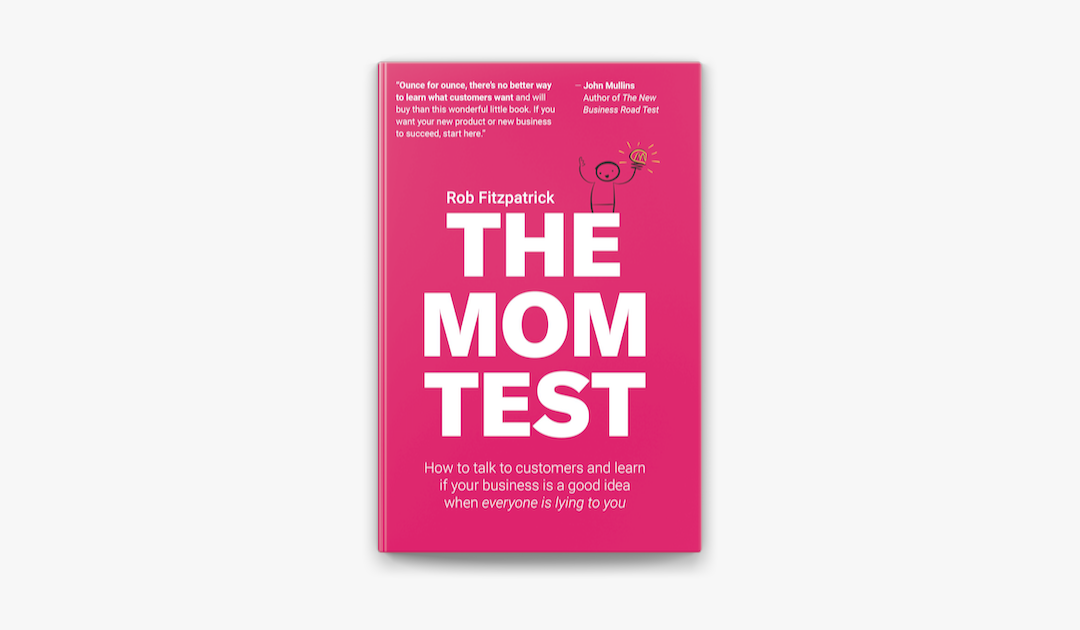Ever wanted simple, practical tips for your startup idea validation?
As an aspiring entrepreneur, I have always wondered how to properly validate a startup idea.
We see so many successful startup ideas that seem obvious to us now, but how did the founders come to that conclusion when they first launched?
What makes some ideas worth pursuing and others not?
When I was younger, I thought it was as simple as finding a problem and creating a solution to it, which on the surface, is true, but as we know there is much more strategy that goes on behind the scenes.
In today’s article, I want to share four useful tips that i have learned from the classic book for entrepreneurs, “The Mom Test” by Robert Fitzpatrick.
“The Mom Test” essentially provides a framework on how to interview customers in a way that doesn’t allow them to lie to you, not even your own mom, which will help you better understand if your idea is worth pursuing.
Here are my important takeaways from the book. Enjoy!
1. Customer Slicing

It seems quite obvious, but it should be reinforced how important it is to properly understand who are you trying to target with your new business idea.
What has led you to believe that the group of people you have in mind would be interested in your offering and from what sources have you collected your hypothesis?
Is there already a good or service like yours out in the market?
If so, great! That means that there is a demand for what you have to provide.
Imagine working 14 hours a day for months to develop an app and once it finally launches, you realize that people don’t have a need to solve the problem you are tackling, or even worse, you don’t even know how to find the people you are looking to attract.
Speaking from personal experience, I ran into a similar situation during my freshman year of high school.
My best friends and I all love to skateboard, and one of our buddies was great at drawing cartoons, so we decided to create t-shirts that blended skateboarding and cartoon characters together and tried to sell them.
Although we thought the shirts were cool, we thought we could just sell them to anyone at the skatepark since people there liked to skateboard, but we quickly realized that we needed to further specify exactly who would like our idea.
Before you conduct any interviews with customers to validate your idea, its important that you have some sort of understanding of what the people you want to attract care about and how your offering would add value to their lives.
The author of “The Mom Test” uses the concept of “customer slicing” to further specify who your conversations are targeted towards.
He gives an example of a founder who is building a high-end fitness gadget for busy people.
Because the gadget is expensive, digital. and for people who are into fitness (these people usually live in big cities), he decides that his customer segment is for high-income individuals, ages 25-35, who live in big cities.
However, this segment doesn’t give you the useful data you need to truly know how to find these people.
I mean where do you even begin to find someone who fits in all of those boxes? It’s too vague.
So to further specify, the founder decides to instead target higher-income individuals in London training for a marathon.
This slice of his customer segment provides a much more useful hint on how to find your target market and gives a more clear depiction of what the market actually cares about.
Since these people are training for a marathon, they must take fitness pretty seriously and would be more open to becoming early adopters of a fitness product than some random person at the gym.
2. Identify Their REAL Pains

There is a common notion amongst the business world that competition is bad, but for investors looking to provide funding for a new startup, it’s one of the first indicators that there is an actual pain point in the market they intend to serve.
Just like in sales, before you start a conversation with someone, it’s important to have at least a baseline understanding of what challenges your customers are facing that are preventing them from reaching their goals.
What would your offering do to help improve your customers’ experience? How would it make your customer feel if that problem was solved?
Is there an offering out there that customers are already paying for? Would they be willing to pay even more money for a service like yours?
All of these are questions you may want to consider before interviewing the market so that you have an objective of what you want to achieve from each conversation.
But as stated heavily in the book, you do NOT want to ask those questions directly, and if you can, try to keep your idea hidden for as long as possible, until it makes sense to introduce it.
I’ll explain how this is done in the next topic.
3. Keep It Casual

One of the largest takeaways from the Mom Test is to not hold conversations that are biased towards you.
The very beginning of the book starts with an example of a kid approaching his mom asking if his idea for a new iPhone app is a good one or not.
Because the mom doesn’t want to hurt her son’s feelings, she tells him everything he wants to hear, leading him on a path to develop an app that is “destined to be successful” because his mom told him so.
This example paints the picture for the rest of the book, and Fitzpatrick can’t emphasize enough how important it is to hold casual conversations without the purpose of winning over a customer.
Instead of asking if your service is a good idea, or if someone would pay for it, the best data will come from understanding how the person you are speaking to goes about handling your topic of interest in their daily life.
By focusing on having a casual conversation, you will receive more authentic information from the person you speak with, whereas on the other hand, if you start a conversation by framing your questions a certain way, they may feel inclined to answer the way you want them to.
For example, if you have an idea for a new social media app and have a hint that others may experience the same frustrations as you, your conversations should start by asking about how they currently use social media and what impact it has on them.
Fitzpatrick takes this a step further and adds a rule in his book that in each conversation, you should ask at least one question that has the potential to disprove your entire idea for a business. Only then will you know if you have a solid idea.
He also mentions that you should keep your idea quiet until it is appropriate to bring it up, because if revealed too early, the recipient of your conversation may exaggerate to try to help you out.
Imagine starting your conversation off with someone you just met by explaining that you have this brilliant idea for an app.
Nine times out of ten, that person will tell you all the words you want to hear because they don’t want to hurt your feelings.
4. Avoid Bad Data

As I mentioned in the previous topic, you want to avoid framing your questions in a way that leads to a favorable outcome.
To get even more specific, Fitzpatrick states that there are three types of bad data that should be avoided at all costs when you are interviewing potential customers.
These are:
- Compliments
- Fluff
- Ideas
Let’s start with numero uno.
Compliments
Just like I mentioned before, compliments should always be taken with a grain of salt.
When someone you are talking to gives you a compliment about your idea, especially if they just met you, they are almost certainly lying to avoid hurting your feelings.
This is why keeping your conversations casual is the best approach since people can oftentimes pick up on your excitement if you come into the conversation too strong.
This is why Fitzpatrick suggests avoiding bringing up your idea in the conversation, but if it does come up, you need to deflect any compliments you are given (but don’t be rude about it) and focus the conversation back on the other person.
Fluff
As you talk to others, you want to avoid using “fluff-induced questioning”.
These phrases sound like:
“Have you ever…”
“Do you ever…”
“Would you ever…”
If you haven’t picked up on the pattern yet, these types of questions illicit hypothetical responses, which are not valuable when collecting data.
I mean think about it, imagine pitching your product to a group of investors and they ask if you have any customers and you tell them “no, but I know a few people that told me they definitely would buy it”.
It’s no good.
Instead, ask more concrete questions that make the other person recall a specific instance in their life when they needed something similar to your offer.
Ideas
If you get to a point further in your conversation where you feel comfortable talking about your new startup idea, be cautious if the person you speak with brings up ideas of their own.
You don’t want to write down every single feature request that the person has without truly understanding why it is that they want that function.
Fitzpatrick uses an example of a potential customer asking the new founder if his software will sync to Excel, and instead of just writing “sync to Excel” in his notes, he responds by asking what syncing to Excel would allow the other person to do.
As a result, he was able to uncover more pains from the other party and found adequate data for his new venture.
Conclusion
These are just a few of the many awesome tips found in Robert Fitzpatrick’s book, “The Mom Test” to help you better validate your new business idea.
As I mention in most of my articles, these are tips that I have found to be most important and this article is not intended to be a definitive list of tips from the book.
If you would like to learn more and haven’t read the book, well, what are you waiting for?!
Check it out here to see why so many entrepreneurs treasure it so much.
Thanks for reading!
Want To Share Your Startup?
Contact us or leave a comment below to be featured in the next blog post.


This book is my JAM right now. Been reading it and practicing everything from it as we’re attempting to validate our idea. Definitely a recommended read for anyone trying to interview potential customers.